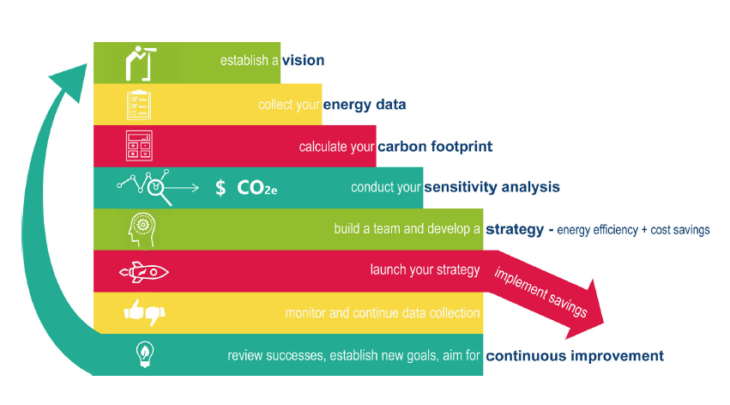THE OGM: 30 YEARS IN BUSINESS Edition - Read Now!
View Past IssuesOur energy bills are about to increase so paying attention to energy and developing a strategy for reducing energy consumption simply makes good business sense.
A ‘pay at the pump’ tax on all fossil fuels. This includes gasoline, diesel, propane, heating oil and is starting no later than 2019.
Canada signed the Paris Accord and agreed to a Nationally Determined Contribution to global carbon emission reductions. From this Accord the Federal Government created the Pan Canadian Framework on Clean Growth and Climate Change and put a price on carbon. The tax is already in place in British Columbia and Alberta and planned for the Atlantic Provinces.
In less than four years we will likely be facing an electricity bill that has doubled and a ‘tax’ of almost 10 cents on our gasoline purchases.
The good news is we have a few years and there are good solutions. For example, Newfoundland Power’s Net Metering Program allows customers to install renewable energy (solar, wind, micro-hydro) sized to offset their energy costs. This is an opportunity to swap an increasing and unstable energy price for a stable financing cost. We are also seeing loans and financing available that support a green new energy sustainable solutions.
Developing a strategy for energy efficiency and carbon emissions reductions is similar to developing other strategies. As illustrated in the graphic in Figure 1, we start by establishing a vision, collecting energy data (electricity and fuel consumed), and calculating a carbon footprint which can be used as a strategic management tool. Once energy consumption and carbon emissions are known, we can benchmark against national and climate appropriate averages, then identify where the significant risks and opportunities lie. Combining the energy use information, carbon inventory, and the risk and opportunity analysis, we can develop a strategy to improve energy efficiency, identify renewable energy and technology solutions, reduce carbon emissions, and save money.
As part of my professional career, I’ve attended carbon seminars, webinars and training sessions. The often overriding theme when it comes to the topic of carbon and emmissions is fear. Fear of change, fear of rising prices, fear of remaining competitive in a tough market. It’s a reasonable reaction, really, but I offer the following as balm and inspiration:
Czech Republic, Hungary, Slovakia, Poland, Denmark, Germany, the UK, and Sweden have all successfully decoupled carbon emissions from GDP growth. This means their GDP has grown and their national carbon emissions have declined. Here in Canada, Quebec, Ontario, and PEI have shown a decoupling trend. Quebec and Ontario both have strong policies on climate change, and PEI has utility-scale wind farms.
Sweden is a particularly good example. They adopted a carbon tax in 1991, which is currently $168 US/t CO2e. It took about five years for GDP to go up and carbon emissions down.
Several of the major companies in Sweden, including McDonald’s, Siemens, and Coca-Cola joined forces and created the Haga Initiative, “… a network of companies that work to reduce carbon emissions from the business sector and highlight that ambitious climate strategies can create business advantage and improve profitability”. In 2017, the Minister of
International Development Cooperation and Climate wrote: “The Initiative’s vision is actually working out so well that these companies have already achieved the previous climate objective of a 40 percent reduction in emissions…” The results from Sweden make sense. For example, a grid-tied solar panel array in Newfoundland can be installed for an average price of 12 cents/kWh and wind can be installed for an average price range of 5-17 cents/kWh depending on where you are and what size turbine is being installed. That’s a stable cost for the life of the system. No increases from inflation, mismanagement, or otherwise. Energy efficiency simply saves money.

Figure 1: Steps for developing a corporate energy strategy
The world is a big place, with lots of intelligent and dedicated people coming up with creative solutions that bridge oil and gas to new energy. From 2000-2010 US-based oil and gas companies invested approximately $9 Billion in renewable energy pilot, demonstration, and offsetting projects. It is conceivable to imagine an offshore wind turbine married to an offshore drilling rig. Today, solar panels are common on oil platforms especially in areas like the middle east where the sun is prevalent.
Bringing it back to the individual business, a great place to start energy efficiency and emissions reduction efforts at no (or very low) cost is with existing employees. Staff most often have a level of knowledge that can be used as a resource for improving efficiency and associated energy use. Setting up an energy-focused employee suggestion board is a great way engage with staff and access knowledge that would otherwise go untapped.
Other no/ low-cost options include: Have a ‘sweater day’ and turn the thermostat down a degree or two.Review lighting: Are the lights on in unoccupied spaces? Review operations in off hours: Are the lights or heat on in unoccupied or ‘dead’ spaces?
Look at operating schedules and controls. For example, can equipment run times be shifted to shave peak kW usage and reduce demand charges.
If budget is available for an energy strategy and the desire exists, good places to start include; a thermal scan of the building, energy efficiency training, fleet route review, fuel-saving driver training, heat recovery technologies, and on-site renewable energy.
One can also engage a consultant to conduct an energy review and create a corporate energy and emissions reduction strategy.
Fundamental Inc. is a consulting firm which helps clients understand and effectively incorporate energy efficiency and the cost savings. Owner and Director, Ashley Smith B.Sc., M.Eng., LEED AP, has 16 years’ experience in sustainability consulting, green building, and construction management.
Did you enjoy this article?
We respect your privacy and will never share your information with third parties.